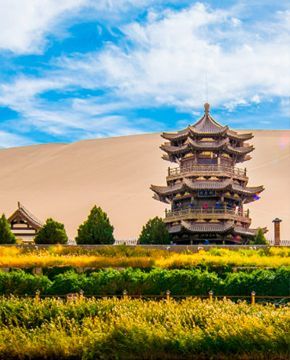As the capital city of Xinjiang Uygur Autonomous Region, Urumqi lies on the northern foothill of the middle section of the Tianshan Mountain, southern edge of the Junggar Basin. It is a major city on the north route of the Silk Road as well as the center for economic and cultural exchanges between the East and the West. The name “Urumqi” was an ancient Junggar Mongolian, meaning “beautiful ranch”. The history of Urumqi can be traced back to the Neolithic Age when mankind began to live and thrive in the area. During the Warring States Period, Urumqi belonged to the territory of the ancient Cheshi people. By Western Han, more than a dozen nomadic tribes inhabited in Urumqi and its surrounding areas, that were referred to in history as “Territory of the Thirteen Kingdoms”. In early Han Dynasty, the imperial court deployed a troop near Urumqi to safeguard the northern route of the Silk Road. In 640, the imperial court of the Tang Dynasty set up the Ting prefecture north of the Tianshan Mountain to manage the four counties. Urumqi area was under Luntai County, one of the four. The ancient ruins left today in the southeast suburbs of Urumqi used to be the then military town, Lutai. In 702(2nd Chang'an year), the Beijing Frontier Command was incorporated in the Ting prefecture administration. More troops were posted in Luntai. A prominent Tang Dynasty frontier poet who had lived in Luntai for three years wrote the following lines to describe the frontier scene: ”west of the watch towers black smoke rise. Han troops are posted north of Luntai”. Another patriotic poet of the Southern Song Dynasty Lu You wrote: ”Lying on my sick bed in an isolated village but i am not sad. I am still thinking about safeguarding the frontier for my country.” Luntai referred to the northern frontier and poems expressed the poets' concerns for the fate of the country and their patriotic feelings.

The mass development of Urumqi started in the Qing Dynasty. Relevant policies were promulgated by the Qing government including encouraging settlement, land reclamation, and reducing taxation. As the local agriculture, commerce and handicraft industry enjoyed rapid development, Urumqi became a prosperous city outside the Yumenguan Pass. In 1758 (23rd year of the Qianlong reign), in order to meet the requirement of a growing population and trade expansion, local troops built an earth stockade outside the present-day south gate, which became the prototype of the present-day Urumqi fortress. In 1763 (28th year of the Qianlong reign), the order earthen fortress expanded further north and reached 2.5kilometers in perimeter. The newly built city was nominated “Dihua” by Emperor Qianlong. In 1884(10th year of the Guangxu reign), with the official establishment of the Xinjiang Province, the military and administrative center was moved from Yili to Dihua where it became the provincial capital.
As a major city for exchange and communication between the East and the West, Urumqi is a multi - ethnic city hosting a total of thirteen ethnic peoples, apart from the Hans, there also inhabit ethnic minorities such as the Uygur, Hui, Kazak, Manchu, Sibo, Mongolian, Kirgiz, Tajik, Tatar, Uzbek, Russian, Daur, etc. Minorities can be found on every street, the entire city demonstrates a strong ethnic style.




